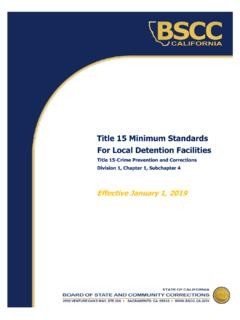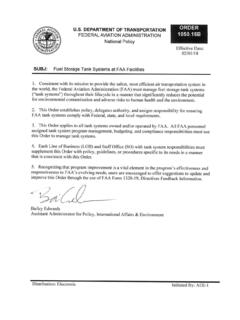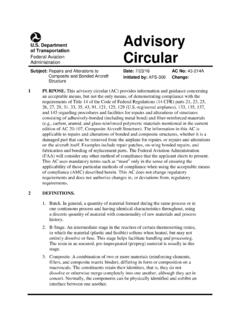Transcription of Design and procurement of storage facilities
1 ` WHO Vaccine Design and procurement of storage facilities Technical supplement to WHO Technical Report Series, No. 961, 2011 Annex 9: Model guidance for the storage and transport of time and temperature sensitive pharmaceutical products January 2014 World Health 2014 WHO Press, World Health Organization, 20 Avenue Appia, 1211 Geneva 27, Switzerland (tel.: +41 22 791 3264; fax: +41 22 791 4857; e-mail: Requests for permission to reproduce or translate WHO publications whether for sale or for noncommercial distribution should be addressed to WHO Press, at the above address (fax: +41 22 791 4806; e-mail: The designations employed and the presentation of the material in this publication do not imply the expression of any opinion whatsoever on the part of the World Health Organization concerning the legal status of any country, territory, city or area or of its authorities, or concerning the delimitation of its frontiers or boundaries.))
2 Dotted lines on maps represent approximate border lines for which there may not yet be full agreement. The mention of specific companies or of certain manufacturers products does not imply that they are endorsed or recommended by the World Health Organization in preference to others of a similar nature that are not mentioned. Errors and omissions excepted, the names of proprietary products are distinguished by initial capital letters. All reasonable precautions have been taken by the World Health Organization to verify the information contained in this publication. However, the published material is being distributed without warranty of any kind, either expressed or implied. The responsibility for the interpretation and use of the material lies with the reader. In no event shall the World Health Organization be liable for damages arising from its use.
3 The named authors alone are responsible for the views expressed in this publication. Technical supplement : Design of storage facilities 2 Acknowledgments The author of this document is Andrew Garnett, WHO consultant, London, UK. Technical supplement : Design of storage facilities 3 Contents Acknowledgments .. 2 Contents .. 3 Abbreviations .. 4 Glossary .. 5 1. Introduction .. 8 Requirements .. 8 8 Target readership .. 9 2. Guidance .. 10 Associated materials and equipment .. 10 Basic concepts .. Error! Bookmark not defined. References .. 27 Revision history .. 33 Technical supplement : Design of storage facilities 4 Abbreviations BREEAM Building Research Establishment Environmental Assessment Method CCTC Closed-circuit television EEFO Earliest-Expiry-First-Out FIFO First-In-First-Out IFRC International Federation of Red Cross and Red Crescent Societies ISO International Standards Organization LEED Leadership in Energy and Environmental Design MSF M decins Sans Fronti res SIA Supplementary Immunization Activity SKU Stock-keeping unit TTSPP Time and Temperature-Sensitive Pharmaceutical Product UPC Universal Product Code VEN Vial, Essential, Nonessential Technical supplement : Design of storage facilities 5 Glossary ABC analysis.
4 Tool for reviewing stock movement, which categorizes items by the volume and value of consumption during a specific period of time, usually one year. Class A items 10 to 20 percent of items, representing 75 to 80 percent of expenditures are mostly high-volume, fast-moving medicines. Class B items are usually 10 to 20 percent of items, and 15 to 20 percent of expenditures. Class C items often represent 60 to 80 percent of the items but only about 5 to 10 percent of the total expenditures; these are the low-volume, slow-moving items. Thus, class C is a good place to look for items that might not be needed in stock at all times. Client: The organisation or individual that is responsible for procuring a building development; sometimes referred to as the employer. Controlled or hazardous products: TTSPPs and other products with high illicit value: poisons, narcotics, psychotropic products, inflammable or explosive substances and radioactive materials.
5 Insulated shipper: A single-use insulated passive container, containing coolant, typically used to distribute TTSPPs by road or air transport. Inventory turnover: A measure of the number of times inventory is sold or used in a time period such as a year. The equation for inventory turnover equals the cost of goods sold divided by the average inventory. Inventory turnover is also known as inventory turns, stockturn, stock turns, turns, and stock turnover. Net storage capacity: The total volume available for storing TTSPPs, taking account of the type of load support system employed (floor-standing pallets, adjustable pallet racking or shelving units), as modified by the utilization factor that can be achieved in the store. Pallet: Wooden or plastic platform designed to be lifted by pallet jack or forklift truck.
6 Typically used for storing and handling tertiary cartons. Passive systems: Systems which maintain a temperature-controlled environment inside an insulated enclosure, with or without thermostatic regulation, using a finite amount of pre-conditioned coolant in the form of chilled or frozen gel packs, phase change materials, dry ice or others. Pharmaceutical product: Any product intended for human use or veterinary product intended for administration to food producing animals, presented in its finished dosage form, that is subject to control by pharmaceutical legislation in either the exporting or the importing state and includes products for which a prescription is required, products which may be sold to patients without a prescription, biologicals and vaccines. It does not, however, include medical devices1.
7 Primary container: Bag, blister pack, strip, bottle, cartridge, vial, ampoule, prefilled device, plastic dispenser, tube, single dose container or the like containing tablet(s), capsule(s), liquid preparation or the like. 1 Definition from WHO/ Rev 1 Sept 2009. Proposal for revision of WHO good distribution practices for pharmaceutical products Draft for comments. Technical supplement : Design of storage facilities 6 Refrigeration equipment: The term refrigeration or refrigeration equipment means any equipment whose purpose is to lower air and product temperatures and/or to control relative humidity. Secondary pack or carton: The pack/carton that contains one or more primary containers; usually constructed of light cardboard.
8 Staging area: Zone(s) of a warehouse designated for the short term storage of incoming goods waiting to be moved into long-term storage , and also for storing outgoing goods awaiting shipment. Standard Operating Procedure (SOP): A set of instructions having the force of a directive, covering those features of operations that lend themselves to a definite or standardized procedure without loss of effectiveness. Standard operating policies and procedures can be effective catalysts to drive performance improvement and improve organizational results. Stock-keeping unit (SKU): In the field of inventory management, a code number, typically used as a machine-readable bar code, assigned to a single item of inventory. As part of a system for inventory control, the SKU represents the smallest unit of a product that can be sold from inventory, purchased, or added to inventory.
9 Applied to wholesale, retail, or production operations, the SKU can assist in monitoring transactions, tracking customer spending patterns, controlling inventory and purchasing, and providing information about pricing2, for example via its Universal Product Code (UPC). In the context of this Technical supplement , and depending on the level in the supply chain, an SKU may be a complete pallet, a tertiary carton, a secondary carton or a primary container. Temperature-controlled: Includes any environment in which the temperature is actively or passively controlled at a level different from that of the surrounding environment within precise predefined limits. Temperature-modified: Includes any environment in which the temperature is predictably maintained at a level different from that of the surrounding environment, but is not actively or passively controlled within precise predefined limits.
10 Tertiary pack or carton: The pack/carton that contains a number of secondary cartons; usually constructed of corrugated fibreboard. Note: the tertiary carton is not the same as the insulated shipper used for international air shipment of TTSPPs, although the insulated shipper may contain one or more of these cartons. Time and temperature sensitive pharmaceutical product (TTSPP): Any pharmaceutical good or product which, when not stored or transported within pre-defined environmental conditions and/or within pre-defined time limits, is degraded to the extent that it no longer performs as originally intended. Utilization factor: The percentage of the total volume available for storing TTSPPs that can reliably be achieved in practice, taking account of the types of stock-keeping unit (SKU), the types of load support system and the stock management systems used in the store.














